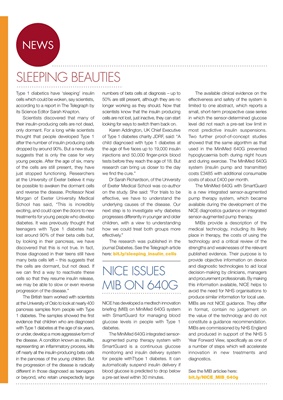
NEWS
SLEEPING BEAUTIES
Type 1 diabetics have 'sleeping' insulin
cells which could be woken, say scientists,
according to a report in The Telegraph by
its Science Editor Sarah Knapton.
Scientists discovered that many of
their insulin-producing cells are not dead,
only dormant. For a long while scientists
thought that people developed Type 1
after the number of insulin producing cells
dropped by around 90%. But a new study
suggests that is only the case for very
young people. After the age of six, many
of the cells are still present, they have
just stopped functioning. Researchers
at the University of Exeter believe it may
be possible to awaken the dormant cells
and reverse the disease. Professor Noel
Morgan of Exeter University Medical
School has said, "This is incredibly
exciting, and could open the doors to new
treatments for young people who develop
diabetes. It was previously thought that
teenagers with Type 1 diabetes had
lost around 90% of their beta cells but,
by looking in their pancreas, we have
discovered that this is not true. In fact,
those diagnosed in their teens still have
many beta cells left - this suggests that
the cells are dormant, but not dead. If
we can find a way to reactivate these
cells so that they resume insulin release,
we may be able to slow or even reverse
progression of the disease."
The British team worked with scientists
at the University of Oslo to look at nearly 400
pancreas samples from people with Type
1 diabetes. The samples showed the first
evidence that children who are diagnosed
with Type 1 diabetes at the age of six years,
or under, develop a more aggressive form of
the disease. A condition known as insulitis,
representing an inflammatory process, kills
off nearly all the insulin-producing beta cells
in the pancreas of the young children. But
the progression of the disease is radically
different in those diagnosed as teenagers
or beyond, who retain unexpectedly large
numbers of beta cells at diagnosis - up to
50% are still present, although they are no
longer working as they should. Now that
scientists know that the insulin producing
cells are not lost, just inactive, they can start
looking for ways to switch them back on.
Karen Addington, UK Chief Executive
of Type 1 diabetes charity JDRF, said: "A
child diagnosed with type 1 diabetes at
the age of five faces up to 19,000 insulin
injections and 50,000 finger-prick blood
tests before they reach the age of 18. But
research can bring us closer to the day
we find the cure."
Dr Sarah Richardson, of the University
of Exeter Medical School was co-author
on the study. She said: "For trials to be
effective, we have to understand the
underlying causes of the disease. Our
next step is to investigate why diabetes
progresses differently in younger and older
children, with a view to understanding
how we could treat both groups more
effectively."
The research was published in the
journal Diabetes. See the Telegraph article
here: bit.ly/sleeping_insulin_cells
NICE has developed a medtech innovation
briefing (MIB) on MiniMed 640G system
with SmartGuard for managing blood
glucose levels in people with Type 1
diabetes.
The MiniMed 640G integrated sensoraugmented pump therapy system with
SmartGuard is a continuous glucose
monitoring and insulin delivery system
for people withTtype 1 diabetes. It can
automatically suspend insulin delivery if
blood glucose is predicted to drop below
a pre-set level within 30 minutes.
NICE ISSUES
MIB ON 640G
The available clinical evidence on the
effectiveness and safety of the system is
limited to one abstract, which reports a
small, short-term prospective case series
in which the sensor-determined glucose
level did not reach a pre-set low limit in
most predictive insulin suspensions.
Two further proof-of-concept studies
showed that the same algorithm as that
used in the MiniMed 640G prevented
hypoglycaemia both during night hours
and during exercise. The MiniMed 640G
system (insulin pump and transmitter)
costs £3485 with additional consumable
costs of about £400 per month.
The MiniMed 640G with SmartGuard
is a new integrated sensor-augmented
pump therapy system, which became
available during the development of the
NICE diagnostics guidance on integrated
sensor-augmented pump therapy.
MIBs provide a description of the
medical technology, including its likely
place in therapy, the costs of using the
technology and a critical review of the
strengths and weaknesses of the relevant
published evidence. Their purpose is to
provide objective information on device
and diagnostic technologies to aid local
decision-making by clinicians, managers
and procurement professionals. By making
this information available, NICE helps to
avoid the need for NHS organisations to
produce similar information for local use.
MIBs are not NICE guidance. They differ
in format, contain no judgement on
the value of the technology and do not
constitute a guidance recommendation.
MIBs are commissioned by NHS England
and produced in support of the NHS 5
Year Forward View, specifically as one of
a number of steps which will accelerate
innovation in new treatments and
diagnostics.
See the MIB articlee here:
bit.ly/nice_mib_640g